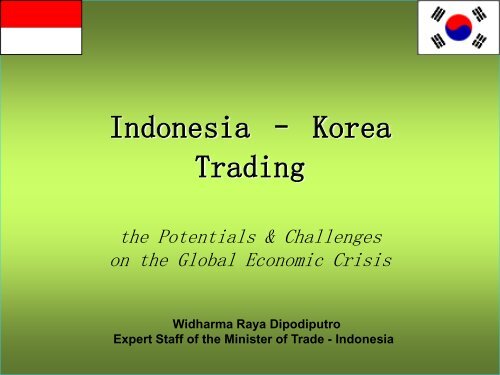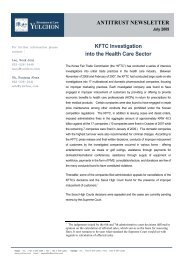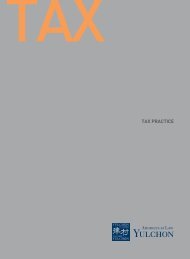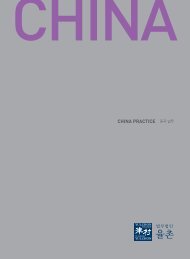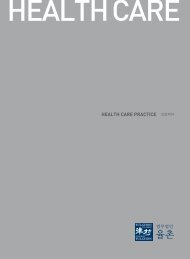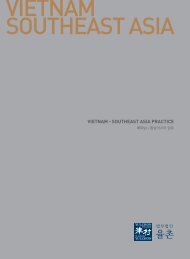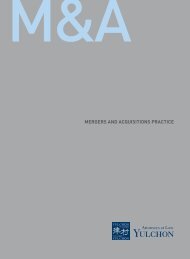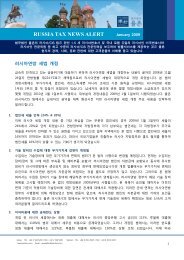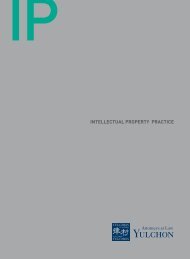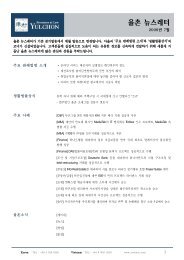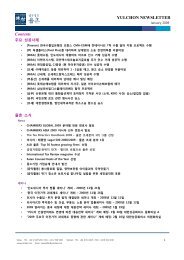ASEAN-KOREA FREE TRADE AREA (AKFTA) - Yulchon
ASEAN-KOREA FREE TRADE AREA (AKFTA) - Yulchon
ASEAN-KOREA FREE TRADE AREA (AKFTA) - Yulchon
Create successful ePaper yourself
Turn your PDF publications into a flip-book with our unique Google optimized e-Paper software.
Indonesia – Korea<br />
Trading<br />
the Potentials & Challenges<br />
on the Global Economic Crisis<br />
Widharma Raya Dipodiputro<br />
Expert Staff of the Minister of Trade - Indonesia
Indonesia – Korea<br />
Trading<br />
| The Republic of Indonesia - Country Overview |<br />
| Current Conditions |<br />
| Potentials & Challenges |<br />
| Important Issues to Discuss |
The Republic of Indonesia<br />
- Country Overview -<br />
• World's fourth most populous country (and the most populous Muslim-majority country)<br />
• Population of approx. 225 million spread across an archipelago of 17,500 islands<br />
• Largest economy in Southeast Asia, with an estimated GDP of approx. USD 433 billion in 2007<br />
• Key sectors are manufacturing, trade/hotel/restaurant, and<br />
agriculture/livestock/forestry/fisheries<br />
• Unitary republic with a presidential system – next general and presidential elections in mid-<br />
2009<br />
The Republic of Indonesia<br />
Composition of GDP by Sector<br />
Manufacturing<br />
7,7%<br />
7,7%<br />
7,6%<br />
27,0%<br />
Trade, Hotel, Restaurant<br />
Agriculture, Livestock,<br />
Forestry, Fishery<br />
Mining, Quarrying<br />
10,1%<br />
Services<br />
11,2%<br />
13,8%<br />
14,9%<br />
Construction<br />
Financial, Ownership,<br />
Business Services<br />
Others<br />
Source: Ministry of Finance<br />
1
Indonesia 2008: Economic Backdrop<br />
• Surging oil prices resulting in widening budget deficit<br />
• Pre-emptive move in reducing fuel subsidies<br />
• Inflation rose to 10.5% y-o-y in September 2008<br />
• Bank Indonesia raised rates to 9.5% in October 2008<br />
• Risks from global financial difficulties and world economic slowdown<br />
• Substantial improvement in economic fundamentals<br />
– Sustained GDP growth of over 6%<br />
– Declining debt-to-GDP ratio<br />
– Strong balance of payments position<br />
Economic Fundamentals Remain Solid<br />
2
Eksport<br />
Millions<br />
Current Conditions<br />
Eksport on 2003-2007<br />
5<br />
4.5<br />
4<br />
3.5<br />
3<br />
2.5<br />
2<br />
1.5<br />
1<br />
0.5<br />
0<br />
2003 2004 2005 2006 2007 Jan-Jul'<br />
07<br />
Year<br />
Jan-Jul'<br />
08<br />
Oil<br />
Non Oil<br />
3
Import<br />
Millions<br />
Current Conditions<br />
Import on 2003-2007<br />
3<br />
2.5<br />
2<br />
1.5<br />
1<br />
0.5<br />
Oil<br />
Non oil<br />
0<br />
2003 2004 2005 2006 2007 Jan-Jul'<br />
07<br />
Year<br />
Jan-Jul'<br />
08<br />
4
Amount<br />
Millions<br />
Current Conditions<br />
Export-Import Balances on 2003-2008<br />
3.9<br />
3.4<br />
2.9<br />
2.4<br />
1.9<br />
1.4<br />
0.9<br />
0.4<br />
-0.1<br />
2003 2004 2005 2006 2007 Jan-Jul'<br />
07<br />
year<br />
Jan-Jul'<br />
08<br />
Oil<br />
Non-Oil<br />
5
Real Growth in Total Trade (%)<br />
Current Conditions<br />
Real growth of trade (%)<br />
Most country groups had substantial real trade<br />
growth, but low-income countries’ slowed down<br />
in 2007<br />
14<br />
12<br />
10<br />
8<br />
6<br />
4<br />
2<br />
0<br />
EAP ECA HI OECD HI non-OECD LAC MNA SAS SSA<br />
1995-1999 2000-2004 2005-2006 2007<br />
Source: World Trade Indicators 2008<br />
• ECA = Europe and<br />
Central Asia<br />
Average<br />
• Hi OECD = High<br />
income OECDs<br />
Average<br />
• EAP = East Asia-<br />
Pacific Average<br />
• LAC = Latin<br />
America and<br />
Caribbean Average<br />
• MNA = Middle East<br />
and North Africa<br />
Average<br />
• SAS = South Asia<br />
Average<br />
• SSA = Sub-Saharan<br />
Africa Average<br />
8<br />
6
Current Conditions<br />
Export Share<br />
Share of Indonesian Export 2003<br />
Share of Indonesian Export 2008<br />
Australia<br />
2,3<br />
Taiwan<br />
Others<br />
20,7<br />
European Union<br />
17,1<br />
Japan<br />
14,4<br />
Australia<br />
1,9<br />
Others<br />
23,7<br />
European Union<br />
13,9<br />
Japan<br />
12,5<br />
2,7<br />
India<br />
3,4<br />
South Korea<br />
3,7<br />
Malaysia<br />
4,9<br />
China<br />
5,9<br />
Singapore<br />
10,1<br />
United States<br />
14,7<br />
Taiwan<br />
2,6<br />
South Korea<br />
4,4<br />
Malaysia<br />
India<br />
5,6<br />
6,5<br />
China<br />
7,6<br />
Singapore<br />
9,8<br />
United States<br />
11,6<br />
7
Potentials & Challenges<br />
Shifts in Balance of Trade<br />
Position of Trade Balance<br />
Country<br />
Declining Balance of Trade<br />
Surplus<br />
From Surplus to Deficit<br />
Increasing Surplus<br />
Indonesia, Singapore,<br />
China, Taiwan<br />
India, Korea, Philippines,<br />
Thailand<br />
Malaysia<br />
8
Current Conditions<br />
N<br />
O<br />
HS<br />
Number<br />
Items<br />
Export in 1000 US$<br />
Prod. BM<br />
<strong>AKFTA</strong> Tariffs<br />
Interest<br />
2005 06 07 08 09<br />
MFN<br />
2001 2002 2003 2004 10<br />
1 260300000 Copper ores an concentrates 303789 269490.5 221612.8 220448.8 NT 1% 1% 1% 0% 0% 0%<br />
2 470329000<br />
3 441213000<br />
chemical wood pulp soda or<br />
sulphate of non-coniferous<br />
Plywood with at least one outer<br />
ply of tropical wood < 6mm<br />
thicknes<br />
111417 139532.8 154138.7 110790.4 NT 0% 0% 0% 0% 0% 0%<br />
67622.6 78972.3 99826.4 74333.4 NT 8% 8% 8% 8% 8% 8%<br />
4 400122160 Sir 20 31689.7 42963 60604.2 73181 NT 1% 1% 1% 0% 0% 0%<br />
5 281410000 Anhydrous Amonia 5368 26798.1 49725.6 28959.7 NT 2% 2% 2% 0% 0% 0%<br />
6 550951000<br />
Other yam of polyester staple<br />
fiber mixed with artificial staple<br />
fiber<br />
16212.4 23261.6 20515.8 28358.4 NT 8% 8% 3% 0% 0% 0%<br />
7 720260000 Ferro-nickel alloys 14507 6666.7 23580.4 27922.3 NT 3% 3% 3% 0% 0% 0%<br />
8 551011100<br />
Single yam of viscose<br />
containing >= 85% of acrylic or<br />
modaclrylic staple fibr<br />
18307.1 28481.1 20916.6 26351.8 NT 8% 5% 3% 0% 0% 0%<br />
9 852110000 Video recording of magnetic tape 1168.5 263.4 758 25850.2 NT 8% 5% 3% 0% 0% 0%<br />
10 550932000<br />
The List of the Top Ten of Non Oil and Gas Export to Korea<br />
Multiple Cabled yam cont >= 85%<br />
of acrylic or modacrylic staple fibr<br />
27903.7 22829.7 22082.6 24523.7 NT 8% 5% 3% 0% 0% 0%<br />
9
Current Conditions<br />
NO<br />
HS<br />
Number<br />
Items<br />
Import in 1000 US$<br />
Prod. BM<br />
<strong>AKFTA</strong> Tariffs<br />
Interest<br />
2005 06 07 08 09<br />
MFN<br />
2001 2002 2003 2004 10<br />
1 290243000 P-Xylene 151329 100834.5 19427 60662.6 NT 0% 0% 0% 0% 0% 0%<br />
2 390760300<br />
3 852520900<br />
4 721012100<br />
5 720918900<br />
Polyethlene Terephathalate in<br />
chips<br />
Other transmission apparatus<br />
incorp reception apparatus<br />
Flat rolled product plated/coated<br />
with tin thick
Potentials & Challenges<br />
Sustained Economic Growth<br />
GDP Y-o-Y<br />
7.0%<br />
6.0%<br />
5.0%<br />
4.0%<br />
3.0%<br />
6.0% 17.6%<br />
5.9% 5.8%<br />
14.9%<br />
Indonesia has been growing at a rate above 6% since 4Q06 supported by<br />
consumption, investment, and export<br />
3.4%<br />
16.7%<br />
3.8%<br />
12.3%<br />
4.4%<br />
10.4%<br />
GDP Export Investment Consumption<br />
15.6%<br />
5.1% 5.1%<br />
11.8%<br />
4.2%<br />
5.0%<br />
11.4%<br />
5.9%<br />
6.0% 6.1%<br />
3.8%<br />
8.3%<br />
8.1%<br />
2.9% 3.0% 3.0%<br />
6.6% 6.8% 7.0% 6.9%<br />
6.4% 6.5%<br />
4.7% 4.7%<br />
9.8%<br />
10.4%<br />
6.9%<br />
6.3%<br />
7.3%<br />
6.3%<br />
-<br />
6.4%<br />
21.0%<br />
18.0%<br />
16.1%<br />
5.6% 15.5%<br />
5.7%<br />
15.4%<br />
5.3%<br />
5.1%<br />
15.0%<br />
12.8%<br />
12.1%<br />
12.0%<br />
9.0%<br />
2.0%<br />
6.0%<br />
1.0%<br />
2.7%<br />
1.4%<br />
0.9% 0.8%<br />
3.0%<br />
0.0%<br />
1Q05 2Q05 3Q05 4Q05 1Q06 2Q06 3Q06 4Q06 1Q07 2Q07 3Q07 4Q07 1Q08 2Q08<br />
0.0%<br />
11
Potentials & Challenges<br />
Strengthening Private Consumption<br />
Consumption credit growth is strong. Car and motorcycle sales, as a proxy of demand, have<br />
recently experienced significant growth<br />
Indonesia Car and Motorcycle Sales<br />
Consumption Credit Growth<br />
80%<br />
50%<br />
60%<br />
40%<br />
40%<br />
20%<br />
30%<br />
29.2%<br />
0%<br />
(20%)<br />
1Q05 1Q06 1Q07 1Q08<br />
20%<br />
10%<br />
(40%)<br />
(60%)<br />
0%<br />
Mar Jun Sep Dec Mar Jun Sep Dec Mar Jun Sep Dec Mar Jun<br />
Car Sales<br />
Motorcycle Sales<br />
Consumption Credit Line 7<br />
12
Potentials & Challenges<br />
Record High Exports Driven by Commodities<br />
Strong Export Growth (USD Billion) Export Price Index (Rebased to 100)<br />
120<br />
250<br />
80<br />
200<br />
150<br />
40<br />
100<br />
0<br />
2003 2004 2005 2006 2007<br />
50<br />
2003 2004 2005 2006 2007 2008<br />
Agri Mineral Manufactured Oil Gas<br />
Non Oil & Gas<br />
Oil & Gas<br />
Both oil & gas and non-oil & gas exports have gained significantly since 2002.<br />
Total exports rose 14.0% to USD 118.01 billion in 2007- volumes and prices of major commodities such<br />
as crude palm oil, nickel, paper and chemicals spiked.<br />
Dependency on the US market has declined – share of exports to U.S has steadily fallen from 13.3% in<br />
2002 to 9.8% for 2007<br />
13
Potentials & Challenges<br />
Improving Investment Climate<br />
New Investment Law passed in April 2007 aims to facilitate foreign investment. Continuous<br />
taxation reform expected to spur further investment<br />
Significant Improvements in Investment Climate<br />
Imported Capital Goods vs. Investments<br />
Equal treatment for domestic and foreign investment (1)<br />
<br />
<br />
<br />
<br />
<br />
<br />
<br />
<br />
Extends the validity of land titles<br />
Rights to appoint foreign management<br />
Unrestricted repatriation of profits and capital<br />
Accelerated reform in tax administration<br />
Simplified VAT audits and improved taxpayer services<br />
quality<br />
5% reduction in corporate income tax rate for listed<br />
companies which meet certain conditions<br />
Reduction in the tax rate on dividend payments to nonresidents<br />
from 20% to 10%<br />
Significant increase in budget allocation for capital<br />
expenditure<br />
100%<br />
90%<br />
80%<br />
70%<br />
60%<br />
50%<br />
40%<br />
30%<br />
20%<br />
10%<br />
14.9%<br />
39.4%<br />
88.1%<br />
15.4%<br />
18.0%<br />
16.0%<br />
14.0%<br />
12.0%<br />
10.0%<br />
8.0%<br />
6.0%<br />
4.0%<br />
2.0%<br />
<br />
Provides better clarity in business activities that are<br />
conditionally open to foreign investors<br />
0%<br />
1Q05 1Q06 1Q07 1Q08<br />
0.0%<br />
Imported Capital Goods (LHS)<br />
Investments (RHS)
Potentials & Challenges<br />
New policies to support investment<br />
1 Investment Law & Procedure<br />
Investment<br />
climate<br />
improvement<br />
2 Tax & Custom Reform<br />
3 Labor & Immigration<br />
4 Trade Licenses<br />
5 Cross Sector Strategic Policy Reform<br />
Infrastructure<br />
6 Sector Restructuring, Corporatisation and Policy Reform<br />
7 Regulation on natural monopoly & investment protection<br />
8<br />
Clear separation on the role of policy maker, regulator,<br />
contracting agency, and operator<br />
9 Coordination Monetary & Fiscal Authority<br />
Financial<br />
(Banking 10 Financial Institution (Banking & Non<br />
11 Capital Market and SOE Privatization<br />
15
Important Issues to Discuss<br />
Trade and<br />
Investment<br />
climate<br />
improvement<br />
1 A list of emergency support needed by both countries<br />
2 A list of new prospective and potential trade for both countries<br />
3 A list of preferences<br />
4 A list of problems & solving.<br />
5 How to speed up the Cross Sector Strategic Policy Reform<br />
Infrastructure<br />
6 How to disseminate the Sector Restructuring, Corporatisation & Policy Reform<br />
7 How to enforce the Regulation on natural monopoly & investment protection<br />
8<br />
How to apply a clear separation on the role of policy maker, regulator,<br />
contracting agency, and operator<br />
9 How to achieve a Productive Coordination amongst Monetary & Fiscal Authorities<br />
Financial<br />
(Banking 10 How to empower the Financial Institution (Banking & Non<br />
11 How to support the Capital Market and SOE Privatization<br />
16
THANK YOU VERY MUCH
Important Projects<br />
by State Budget on 2009<br />
Toll Road Trans Java: Government Financing Support
Important Projects<br />
by State Budget on 2009<br />
Electricity 10.000 MW Project Guarantee Support
Important Projects<br />
by State Budget on 2009<br />
Financing Policy: Prioritizing from Domestic Financing
Supports on the Real Sector<br />
‣ Maintaining A Sound Balance of Payment<br />
• Deficit Current Account (or even surplus);<br />
• Effort to attract FDI, e.g. Revision PP 1/2007 PP 62/2008;<br />
• Improving Investment climate to attract investors Inpres 5/2008<br />
• Incentive for export;<br />
• Curbing import, especially for Consumption goods;<br />
• Maximizing income from Tourism, Travels, Services and remittances.<br />
‣ Supporting Business Community:<br />
• Seamless flows of transportation and logistic<br />
• Managing UMR (Minimum Wage)<br />
• Managing electricity supply<br />
• Easier for claiming Tax Return<br />
• Closer coordination to Local governments, including to cut unfriendly local regulations<br />
• Enhancing Venture Capital scheme<br />
• Love Domestic product Campaign<br />
• Implementing PP 62/2008, dated 23 Sept 2008 on Value Added Tax for Investment in certain<br />
region or/and certain business (as Revision of PP 1/2007)
Supports on the Real Sector<br />
I. Ensuring the Competitiveness<br />
1) Trade Facilitation: Ensure the efficiency of imports/exports:<br />
• NSW<br />
• Slash the high cost economy: ports, restitution<br />
2) Trade Promotion:<br />
• TEI<br />
• Market diversification: strategic and segmented<br />
• Product diversification<br />
3) Trade Negotiations and Lobby:<br />
• Market Access: lower obstacles (e.g. <strong>ASEAN</strong>-Australia-New Zealand and <strong>ASEAN</strong> India<br />
Free Trade Area)<br />
• Anticipate protectionist activities<br />
II. To Secure the National Markets<br />
a. Optimize Comprehensive steps to tackle smuggling<br />
b. Instruments to secure trade:<br />
- Dumping and safeguards<br />
- Safeguarding products in circulation<br />
- Government budget / procurement<br />
- And others
KEBIJAKAN PEMERINTAH<br />
1. Peraturan Menteri Keuangan No. 134/PMK.011/2008<br />
Tentang:<br />
Bea masuk ditanggung Pemerintah atas Impor Barang dan Bahan untuk Memproduksi<br />
Barang dan/atau Jasa Guna Kepentingan Umum dan Peningkatan Daya Saing Industri Sektor<br />
Tertentu untuk Tahun Anggaran 2008.<br />
2. Peraturan Menteri Keuangan No. 137/PMK.011/2008<br />
Tentang:<br />
Perubahan Kedua atas Peraturan Menteri Keuangan nomor 620/PMK.03/2004 Tentang Jenis<br />
Barang Kena Pajak yang Tergolong Mewah selain Kendaraan Bermotor yang Dikenakan<br />
Pajak Penjualan atas Barang Mewah.<br />
3. Peraturan Menteri Keuangan No. 138/PMK.011/2008<br />
Tentang:<br />
Bea Masuk Ditanggung Pemerintah atas Impor Barang dan Bahan Guna Perbaikan dan<br />
Pemeliharaan Pesawat Terbang untuk Tahun Anggaran 2008.<br />
4. Peraturan Menteri Keuangan No. 139/PMK.011/2008<br />
Tentang:<br />
Bea Masuk Ditanggung Pemerintah atas Impor Barang dan Bahan oleh Industri Jasa<br />
Pelayaran Guna Perbaikan dan/atau Pemeliharaan Kapal Laut untuk Tahun Anggaran 2008.
KEBIJAKAN PEMERINTAH<br />
5. Peraturan Menteri Keuangan No. 140/PMK.011/2008<br />
Tentang:<br />
Bea masuk ditanggung Pemerintah atas Impor Barang dan Bahan Guna Pembuatan<br />
Komponen Kendaraan Bermotor untuk Tahun Anggaran 2008.<br />
6. Peraturan Menteri Keuangan No. 141/PMK.011/2008<br />
Tentang:<br />
Bea masuk ditanggung Pemerintah atas Impor Barang dan Bahan Guna Pembuatan<br />
Komponen Elektronika untuk Tahun Anggaran 2008.<br />
7. Peraturan Menteri Keuangan No. 142/PMK.011/2008<br />
Tentang:<br />
Bea Masuk Ditanggung Pemerintah atas Impor Barang dan Bahan oleh Industri Perkapalan<br />
Guna Pembuatan dan/atau Perbaikan Kapal untuk Tahun Anggaran 2008.<br />
8. Peraturan Menteri Keuangan No. 144/PMK.011/2008<br />
Tentang:<br />
Bea Masuk Ditanggung Pemerintah atas Impor Barang dan Bahan Guna Pembuatan Botol<br />
Infus untuk Tahun Anggaran 2008.
KEBIJAKAN PEMERINTAH<br />
9. Peraturan Menteri Keuangan No. 145/PMK.011/2008<br />
Tentang:<br />
Bea masuk ditanggung Pemerintah atas Impor Barang dan Bahan oleh Industri Pengolahan<br />
Susu untuk Tahun Anggaran 2008.<br />
10.Peraturan Menteri Keuangan No. 146/PMK.011/2008<br />
Tentang:<br />
Bea masuk ditanggung Pemerintah atas Impor Barang dan Bahan Guna Pembuatan<br />
Komponen untuk Pembangkit Listrik Tenaga Uap untuk Tahun Anggaran 2008.<br />
11. Peraturan Menteri Keuangan No. 147/PMK.011/2008<br />
Tentang:<br />
Bea Masuk Ditanggung Pemerintah atas Impor Barang dan Bahan Guna Pembuatan Cold<br />
Rolled Coil (CRC) oleh Industri Baja Nasional untuk Tahun Anggaran 2008.<br />
12.Peraturan Menteri Keuangan No. 148/PMK.011/2008<br />
Tentang:<br />
Bea Masuk Ditanggung Pemerintah atas Impor Barang dan Bahan oleh Industri Pembuatan<br />
Sorbitol untuk Tahun Anggaran 2008.
KEBIJAKAN PEMERINTAH<br />
13.Peraturan Menteri Keuangan No. 154/PMK.011/2008<br />
Tentang:<br />
Pembebasan Bea masuk atas Impor Barang Modal dalam rangka Pembangunan dan<br />
Pengembangan Industri Pembangkit Tenaga Listrik untuk Kepentingan Umum.<br />
14.Peraturan Menteri Keuangan No. 162/PMK.011/2008<br />
Tentang:<br />
Pencabutan Keputusan Menteri Keuangan Nomor 397/KMK.01/2004 Tentang Pengenaan Bea<br />
masuk Inti Dumping Terhadap Impor Carbon Black.<br />
15.Peraturan Menteri Keuangan No. 143/PMK.011/2008<br />
Tentang:<br />
Bea masuk ditanggung Pemerintah atas Impor Barang dan Bahan Guna Pembuatan Bagian<br />
Tertentu Alat Besar dan/atau Perakitan Alat Besar oleh Industri Alat Besar untuk Tahun<br />
Anggaran 2008.


